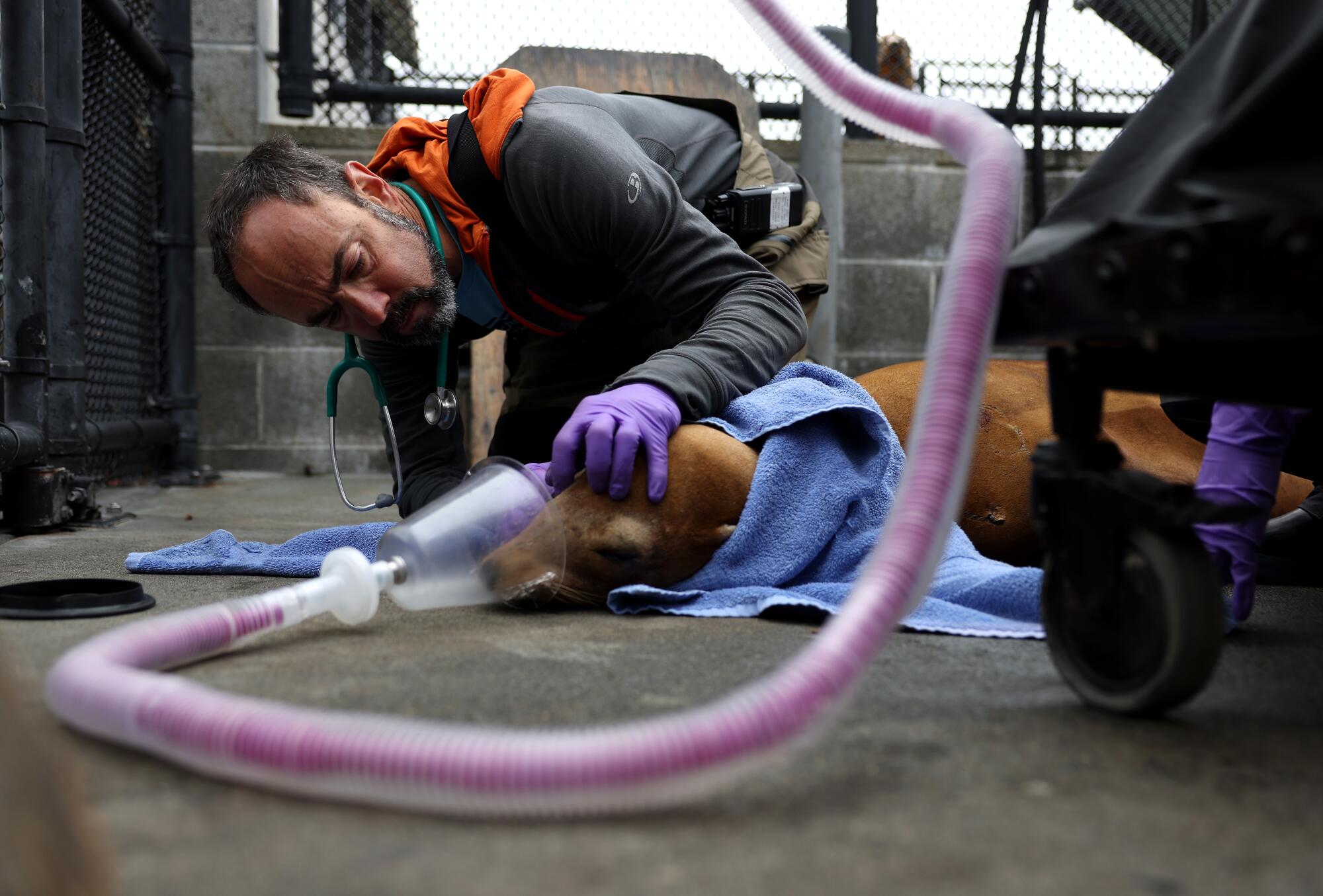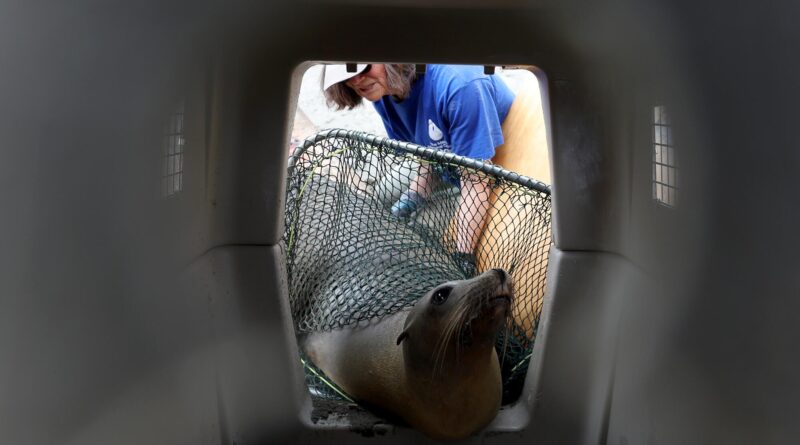A neurotoxin outbreak has killed an unprecedented number of sea lions off the coast of California
By the time the rescue team reached him, a small crowd had gathered around the distraught California sea lion. As the group crept towards him – carrying large wooden shields and a large net – the animal’s head weaved, dragged and swayed back and forth in a strange rhythm.
Lucille – as she was later named by the Marine Mammal Center’s Morro Bay field office – had barely registered her captors when a group of five animal rescue volunteers pounced on her. A small struggle ensued as the creature’s body struggled with the convulsions, but eventually the team was able to push him into the XXL portable dog crate.
“It’s very difficult when they don’t behave like sea lions,” said Jake Roth, a 22-year-old volunteer who helped with the rescue.
It was the first of many distressed calls for help that day, as the domoic acid outbreak continued to wreak havoc on the San Luis Obispo and Santa Barbara beaches this summer. this one.
“The conditions we’re finding in these animals are unusual,” said Giancarlo Rulli, a spokesman for the Sausalito-based Aquatic Center. “It’s all in hands on deck.”
Domoic acid is a neurotoxin produced by Pseudo-nitzschiaa common type of phytoplankton found in coastal waters. Sea lions – and other marine mammals – are poisoned when they eat large amounts of fish or invertebrates that have been eating contaminated diatoms.
Symptoms include fatigue, vomiting, unusual behavior, depression, pregnancy loss and death.

Marine Mammal Center volunteer Cris Lewis guides a sick sea lion in a crate during a rescue at Cayucos State Beach.
(Justin Sullivan/Getty Images)
Domoic acid, an amino acid, is not always produced by phytoplankton. It is only done under certain conditions – which scientists are still trying to figure out. But sea level rise appears to be normal – and cold, nutrient-rich waters are still near the coast of Central California.
The outbreak has been in critical condition since late July.
One of the things that has come up repeatedly in many of our studies … ,” said Clarissa Anderson, director of the Southern California Coastal Ocean Observing System and the Cooperative Institute for Marine, Earth, and Atmospheric Systems, which is run by UC San Diego’s Scripps. Institution of Oceanography.
But the big question – which we haven’t been able to fully wrap our heads around – is when does it become toxic? What combination of circumstances requires that? Because this body is always there,” he said.
Domoic acid eruptions are nothing new. They have been happening for decades, if not thousands of years. Although it was not detected in California waters until 1991, it is believed to have been the cause of earlier outbreaks – including the 1961 “invasion” of disturbed seabirds in Capitola that inspired the film Alfred Hitchcock’s 1963, “The Birds.”
What has changed, Anderson said, is the frequency, timing and location of events.
“We know that the comfortable season in California has always been a good time to look forward to Pseudo-nitzschia flower and it can be a domoic acid event, and it can start at the beginning of March,” he said. As a result, scientists associated the season with the explosion of domoic acid.
“But now we’re starting to see something different: The last three summers there have been these strong, long, lasting blooms,” he said.
And while Monterey and Humboldt Bay were considered old hot spots, it’s Southern California that has been around since 2022.
He said climate change may play a role in these changes – but not necessarily because of warmer water temperatures.

Marine Mammal Center veterinarian Greg Frankfurter examines a recently adopted California sea lion rescued from a beach showing signs of domoic acid poisoning in Sausalito.
(Justin Sullivan/Getty Images)
“One of the things we’ve seen in our years and years and years of data is that it’s the combination of nutrients that come in and boost that can be responsible for turning off or turning off toxins,” he said. “And that nutrient mix can be affected by global climate change, because climate change changes the physics of ocean circulation at the ocean scale – like the Pacific Ocean scale – and that can they have an effect on what kind of water – the taste of the water – is rising up the coast of California.”
Raphe Kudela, a professor of marine science at UC Santa Cruz, says there may be a connection between the temperature and the water from the inland rivers.
He said in the past few years, wet winters have contributed to increased river levels – and the effect of dumping nutrients into California’s coastal waters.
“So you get high energy, which brings cool water with a lot of nutrients to the surface, and then everything warms up. It’s perfect conditions for a flower like this,” he said.
It’s also the perfect recipe for creatures like sardines and anchovies, which feed on diatoms, algae and phytoplankton in these cool, nutrient-rich waters. And those fish bring predators, such as sea lions, dolphins, fur seals, birds and other fish that then eat these “poison bullets.”
Anderson said people will ask him from time to time if they can get sick from eating anchovies.
I’m like, do you plan to eat as much anchovy as a sea lion? He said, noting that sea lions eat about 5% to 8% of their body weight per day. For a 150-pound person, that’s about 7.5 to 12 pounds of anchovy.
And that is part of the tragedy of this latest epidemic.
Barbie Halaska, a neurologist at the Marine Mammal Institute, showed visitors a milky tissue covered with six-inch fins that she made from the chests of six dead sea lions at the facility. Morro Bay.
All six of them were big, lactating women, he said, with a lot of fat.
“You can see how big he is. He is beautiful,” said Halaska, pointing to the dead but healthy-looking animal. “They have a good supply of food. It just happens to be dirty. As they nurse, and find a good supply of food, they walk away. Unfortunately, that means the neurotoxin just accumulates. ”
He said female sea lions usually give birth around June 15 – “we call it the sea lion’s birthday” – meaning the females likely had and small cubs, who depend on them before they are desperate. Sea lion cubs are dependent on their mothers until they are 9 months old.
Studies show that puppies raised in infected mothers suffer from brain damage. Milk from infected women also contains the toxin, suggesting it can be passed on to the offspring.
By afternoon, Lucille and three other sea lions were being treated for domoic acid poisoning.
Lucille was exhausted, snoring on the cement floor with a pen. Shortly after his arrival, a staff member had administered a syringe full of phenobarbital and midazolam to his back, to control seizures. Staff hooked him up to an IV bag of fluids to help flush toxins from his body.
But one of the three newcomers, a large, elderly woman named Yippee, arrived with a broken jaw. The workers decided that he would die if he was sent back to the country. They made the difficult decision to kill him with medicine.
He struggled to get away from the small group that had come to take out the gun, but he ended up being backed into a corner and surrendered. His breathing slowed and after a few minutes, he was quiet.
Rulli said such incidents are always tragic, and the agency works hard to support the personnel who respond to these incidents. Frequent contact with animals in distress can be dangerous.
About 30% of the animals that came to the center in this latest epidemic – which began in late July – have died, said Aliah Meza, operations manager of the Morro Bay field office.
Further south, where Channel Islands Marine Wildlife Institute staff respond to animals off the coast of Santa Barbara and Ventura, the number is more than 50%, said Sam Dover, founder and chief veterinarian of Channel Islands Marine and Wildlife. Institute.
To keep these facilities running and these groups working, both organizations depend on donations and a certain level of state and federal funding.
State funding was nearly withdrawn last year when the governor’s office received $2 million from the state budget. For smaller operations, like Dover’s, that would have had a 50% impact on its operating budget. The groups were able to convince lawmakers to replace the funds.
“I don’t envy the job,” said Jeffrey Boehm, the navy’s chief external relations officer, who said he and others went to Sacramento to make the case that their work is in the public interest. which they used to do with a pencil and a pencil. . “Having an institution that is ready, skilled and professional to respond to wild animals that may exist on the beaches, that is in the interest of the community. Like the technologies that we advance by doing this work… Because at the end of the day, it’s just one system.”
Lucille, who recovered from the fall, was taken to the facility in Sausalito by air-conditioned truck the next day. He died in transit.
Veggie, another sea lion rescued that same day, made it to Sausalito anyway. He is currently in a seven-day hospital, where about 50 other lions are being treated.
Rulli said two sea lions were recently released at Point Reyes National Seashore, where there is no sign of an explosion and where humpback whales are feeding – a sign that there is plenty of food available.
“Let’s just hope they will stay up here,” he said.
#neurotoxin #outbreak #killed #unprecedented #number #sea #lions #coast #California
